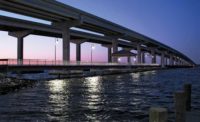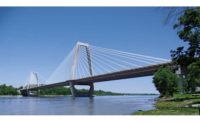Brookfield, Vt.
Key Players
Owner Vermont Agency of Transportation
Lead Designer T.Y. Lin International
General Contractor Miller Construction
Structural/Civil Engineer T.Y. Lin International
Naval Architecture The Glosten Associates
Geotechnical Engineering GeoDesign Inc.
The 321-ft-long, 24-ft-wide structure is the only floating bridge in the U.S. composed of glued laminated timber approach ramps connected to a 261-ft-long floating span, which is supported by fiber-reinforced polymer pontoons. Closed-cell foam inside the pontoons act as a secondary, redundant flotation system.
The use of FRP in bridge construction is typically limited to a secondary role, such as reinforcement for new concrete decks or fiber-wraps for rehabilitating columns or beams. As such, there were no published codes or documented examples to guide the design of an FRP-based primary resisting system. In addition, FRP fabrication guides are typically fabricator-specific and follow an allowable or working stress design philosophy, according to the team.
To overcome these limitations, the project team collaborated with regional fabricators and University of Maine researchers to develop pontoon construction specifications, incorporating a variety of other material types and mechanical properties that allow for flexibility in fabrication. Additional research was required once construction was underway to overcome issues such as difficulties receiving some of the desired stainless steel and a shortage of welders qualified to work with stainless steel.
The completed bridge is located on a low-use road that carries approximately 110 vehicles per day and provides a lakeside crossing for one-way alternating vehicular traffic and pedestrians. It was designed to blend with its rural surroundings, matching the gray/tan FRP pontoons with the structure’s southern pine timber elements to emulate the look of previous crossings that date back to the 1820s. The floating bridge complements the natural beauty of the project site by utilizing natural materials and maintaining a low profile across the lake.
To avoid lengthy underwater tethers or vertical above-water guide piles, a lateral-force resistant system was incorporated beneath the approach ramps. Not visible to users, this system is confined to the footprint of the bridge and does not affect boaters and swimmers.
The team boasts that completion of the floating bridge demonstrates the viability of developing more global standards for FRP floating bridge pontoons and other marine structures in accordance with load and resistance factors.
The team tallied 16,810 work hours with no lost-time accidents. The new bridge is the eighth generation—the last being built in 1978.







Post a comment to this article
Report Abusive Comment